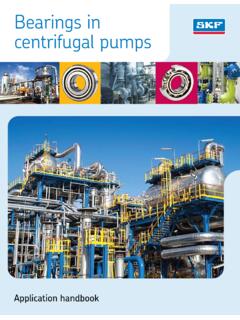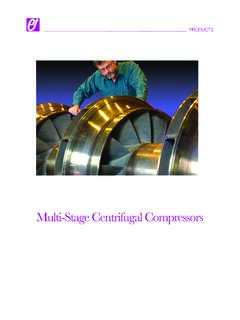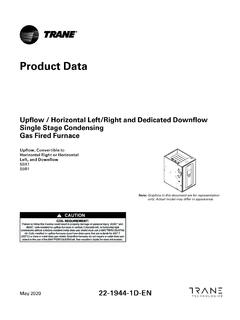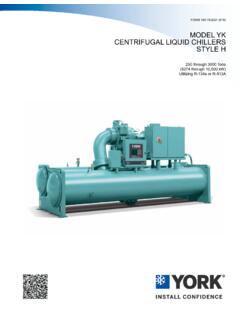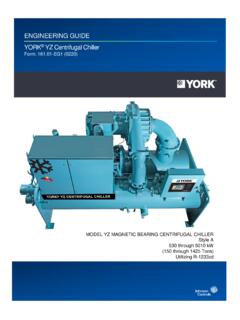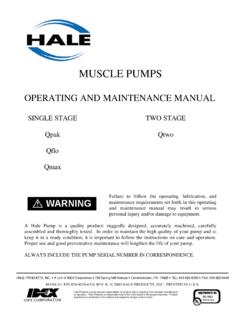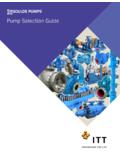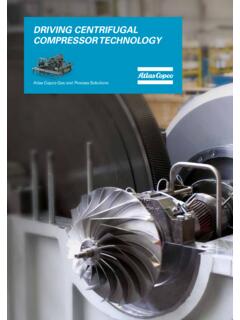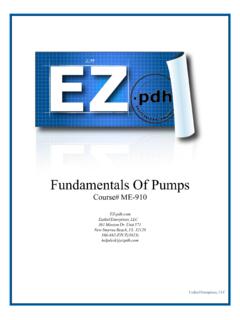Transcription of Problem Solving - Centrifugal Pumps
1 Problem Solving - Centrifugal Pumps The information provided in this document is given in good faith, but Alfa Laval is not able to accept any responsibility for the accuracy of its content, or any consequences that may arise from the use of the information supplied or materials described. Inside View This document has been produced to support pump users at all levels, providing an invaluable reference tool. It includes information on general Centrifugal pump problems and their effect on Centrifugal Pumps with suggestions as to probable causes and solutions. Main sections are as follows: 1.
2 Introduction 2. Centrifugal Pump Problems 3. Alfa Laval Solutions to Specific Centrifugal Pump Problems 4. How correct System Design and Installation can avoid potential problems 5. Problem Solving Table Contents Page Section : Introduction 3 Introduction to Problem Solving Centrifugal Pumps . Section : Centrifugal Pump Problems 5 Overview of pump problems typically found on Centrifugal Pumps . No or low flow 7 No or low pressure 14 Excessive power consumption 15 Excessive noise or vibration 16 Seal leakage
3 20 Section : Alfa Laval Solutions to Specific Centrifugal Pump Problems 31 How Alfa Laval can provide solutions to specific pump problems. Ability to self-prime 31 Ability to handle high inlet pressures 32 Rouging 33 Section : How correct System Design and Installation can avoid 35 potential problems Advises guidelines relating to correct pump installation, system design and pipework layout. Pipework 35 Protection 35 Operation 36 Pre-start up Checks 36 Section.
4 Problem Solving Table 37 Provides summary of probable causes and solutions to the most common problems. Introduction In most pumping systems, the pump is likely to be one of the most vulnerable components and systems frequently show the pump to be at fault regardless of what may be wrong. Upon investigation the likely causes of the Problem are inadequate control of the pumped fluid or a change in operating requirements of which the system or pump is not capable of handling. Pumps that are correctly installed and operated within their design parameters will give typically long trouble-free service of >10 years, unless on very arduous duties. In order to correctly identify the Problem it is important to gather as much information relating to the process as follows: Reconfirm original duty requirements and/or system design.
5 Check for any process changes pressure, temperature, fluid viscosity etc. Check whether the system was undergoing routine maintenance. How long did the pump operate before the Problem . Check the appearance and condition of the pump internal components. Check when the pump was last serviced. Check for any changes in pump noise or vibration. This will save considerable time and effort in leading to the most appropriate solution. The most common problems associated with Centrifugal Pumps are shown herein with particular effects on our range of Centrifugal Pumps . Centrifugal Pump Problems Typical pump problems include: No or low flow No or low pressure Excessive power consumption Excessive noise or vibration Seal leakage These are common for all Centrifugal pump types shown as follows.
6 Pumps Positive DisplacementRotodynamic Rotor Reciprocating Multi- stage single stage Multi-Rotor single Rotor Diaphragm Plunger End Suction Double Entry Screw Gear - Internal Circumferential Piston Rotary Lobe Archimedian Screw Flexible Member Peristaltic Vane Progressing Cavity Piston Simplex Multiplex Process Rubber Lined Submersible General Gear - External 6 Typical causes are as follows.
7 No or low flow Pump is not primed The motor is turning pump in the wrong direction Valves are closed or there is an obstruction in the suction or discharge pipework The end of the suction pipework is not submerged A strainer or filter is clogged Insufficient Net Positive Suction Head available (NPSHa) Air leak in the suction pipe No power to the pump Pump speed too low Pumped media viscosity is higher than expected Pressure is higher than calculated Flow switch faulty No or low pressure Valves are closed or there is an obstruction in the suction or discharge pipework A strainer or filter is clogged on the inlet Flow is higher than calculated The motor is turning pump in the wrong direction Insufficient Net Positive Suction Head available (NPSHa)
8 No power to the pump Pump speed too low Pumped media viscosity is higher than expected Excessive power consumption Flow is higher than calculated with low outlet pressure Viscosity too high Mechanical contact in the pumphead Excessive noise or vibration Pipework is not properly supported Pump is cavitating Impeller contact with casing/backplate Gas entrainment Loss of shaft support (bearing failure in motor) Pumped media contains unexpected abrasive particles Poor pipework / system design Dry running of seal Seal leakage Pumped media contains unexpected solids Chemical corrosion / attack Pump is cavitating Too high discharge pressure Too high temperature Pump / shaft vibration Incorrect fitting Incorrect selection of seal materials Pump allowed to run dry Insufficient or no auxiliary flushing services No or low flow Pump is not primed Centrifugal Pumps are capable of evacuating (pumping) a modest amount of air from the suction side of the pump to the discharge side of the pump.
9 Filling the inlet system with fluid or at least filling the pump (wetted pumping elements) will make a major improvement in the pump s priming capability. The motor is turning pump in the wrong direction Centrifugal Pumps should never be allowed to operate in the wrong direction of rotation. If the pump is not fitted with an impeller screw the impeller may unscrew from the shaft making contact with the casing, thereby causing seizure. To ensure correct direction of rotation the motor can be started and stopped momentarily to check the motor fan is rotating clockwise as viewed from the rear end of the motor. Impeller damage Fluid OutFluid In View from rear end Correct rotation 8If an impeller screw is fitted, the pump is still capable of achieving low flow with the motor turning in wrong direction.
10 If pump is operating in reverse rotation, use motor manufacturers instructions to ensure appropriate direction. Valves are closed or there is an obstruction in the suction or discharge pipework Any obstruction in the pipework and/or valves being closed can significantly increase pressure. An increase in pressure on the outlet will have the effect of a decrease in flow, highlighted in curve below: Impeller screw Pump curve Duty point Increase in pressure Resultant decrease in flow 9 Pressure action on Surface of liquid (Pa)Pressure drop (hfs) The following symptons may occur: Low outlet pressure (see ) Seal dry running (see ) Increase in noise/vibration (see ) Reduced NPSHa (see ) The end of the suction pipework is not submerged In this situation no fluid will be allowed to enter the pump, cavitation may occur (see below) and potential for dry running of seal (see ).
